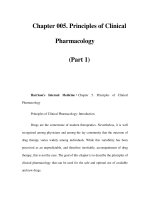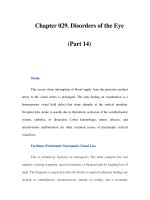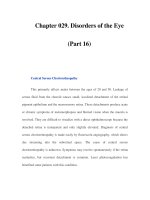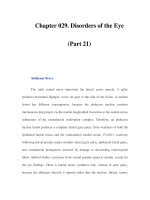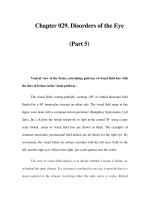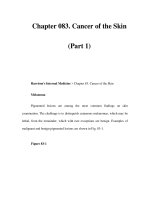Chapter 091. Benign and Malignant Diseases of the Prostate (Part 1) pps
Bạn đang xem bản rút gọn của tài liệu. Xem và tải ngay bản đầy đủ của tài liệu tại đây (64.99 KB, 5 trang )
Chapter 091. Benign and Malignant
Diseases of the Prostate
(Part 1)
Harrison's Internal Medicine > Chapter 91. Benign and Malignant
Diseases of the Prostate
Benign and Malignant Diseases of the Prostate: Introduction
Benign and malignant changes in the prostate increase with age. Autopsies
of men in the eighth decade of life show hyperplastic changes in >90% and
malignant changes in >70% of individuals. The high prevalence of these diseases
among the elderly, who often have competing causes of morbidity and mortality,
mandates a risk-adapted approach to diagnosis and treatment. This can be
achieved by considering these diseases as a series of states. Each state represents a
distinct clinical milestone for which intervention(s) may be recommended based
on current symptoms or the risk of developing symptoms or death from disease
within a given time frame (Fig. 91-1). For benign proliferative disorders,
symptoms of urinary frequency, infection, and potential for obstruction are
weighed against the side effects and complications of medical or surgical therapy.
For prostate malignancies, the risks of developing the disease, symptoms, or death
from cancer are balanced against the morbidities of the interventions
recommended and preexisting comorbid conditions.
Figure 91-1
Clinical states of prostate cancer. PSA, prostate-specific antigen.
Anatomy and Pathology
The prostate is located in the pelvis and is surrounded by the rectum, the
bladder, the periprostatic and dorsal vein complexes that are responsible for
erectile function, and the urinary sphincter that is responsible for passive urinary
control. The prostate is composed of branching tubuloalveolar glands arranged in
lobules and surrounded by a stroma. The acinal unit includes an epithelial
compartment made up of epithelial, basal, and neuroendocrine cells and a stromal
compartment that includes fibroblasts and smooth-muscle cells. The compartments
are separated by a basement membrane. Prostate-specific antigen (PSA) and acid
phosphatase are produced in the epithelial cells. Both prostate epithelial cells and
stromal cells express androgen receptors and depend on androgens for growth.
Testosterone, the major circulating androgen, is converted by the enzyme 5α-
reductase to dihydrotestosterone in the gland.
The periurethral portion of the gland increases in size during puberty and
after the age of 55 due to the growth of nonmalignant cells in the transition zone of
the prostate that surrounds the urethra. Most cancers develop in the peripheral
zone, and cancers in this location can often be palpated during a digital rectal
examination (DRE).
Prostate Cancer
In 2007 in the United States, ~218,890 prostate cancer cases were
diagnosed, and 27,050 men died from prostate cancer. The absolute number of
prostate cancer deaths has decreased in the past 5 years; this has been attributed by
some to the widespread use of PSA-based detection strategies. However, screening
has not been shown to improve survival in prospective randomized trials. The
paradox of management is that although the disease remains the second leading
cause of cancer deaths in men, only 1 man in 8 with prostate cancer will die of his
disease.
Epidemiology
Epidemiologic studies show that the risk of being diagnosed with prostate
cancer increases by a factor of 2 if one first-degree relative is affected and by 4 if
two or more are affected. Current estimates are that 40% of early-onset and 5–10%
of all prostate cancers are hereditary. Prostate cancer affects ethnic groups
differently. Matched for age, African-American males compared to white males
have both a greater number of prostatic intraepithelial neoplasia (PIN) lesions,
which are precursors to cancer, and larger tumors, possibly related to the higher
levels of testosterone seen in African-American males. PIN, the precursor of
cancer, is typically multifocal and highly unstable. Polymorphic variants of the
androgen receptor gene, the cytochrome P450 C17 gene, and the steroid 5α-
reductase type II (SRD5A2) gene have also been implicated in the variations in
incidence.
The incidence of autopsy-detected cancers is similar around the world,
while the incidence of clinical disease varies. Thus, environmental factors may
play a role. High consumption of dietary fats, such as α-linoleic acid, or the
polycyclic aromatic hydrocarbons that form when red meats are cooked is
believed to increase risk. Similar to breast cancer in Asian women, the risk of
prostate cancer in Asian men increases when they move to Western environments.
Protective factors include consumption of the isoflavinoid genistein (which
inhibits 5α-reductase), cruciferous vegetables that contain the isothiocyanate
sulforaphane, retinoids such as lycopene (in tomatoes), and inhibitors of
cholesterol biosynthesis (e.g., statin drugs). The antioxidants α-tocopherol
(vitamin E) and selenium may also reduce risk.
The development of a prostate cancer is a multistep process. One early
change is hypermethylation of the GSTP1 gene promoter, which leads to loss of
function of a gene that detoxifies carcinogens. A role for inflammation has been
suggested based on the finding that many prostate cancers occur adjacent to a
lesion termed PIA (proliferative-inflammatory atrophy). This also suggests a role
for oxidative damage.



